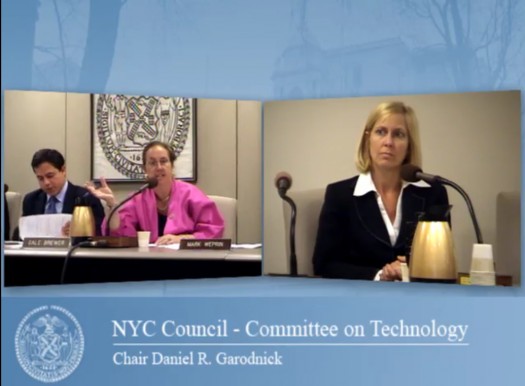
We are celebrating 15 years — and counting — of stories that are deeply researched and deeply felt, that build a historical record of what the city has been.
We are celebrating 15 years — and counting — of stories that are deeply researched and deeply felt, that build a historical record of what the city has been.

Council Members D. Garodnick and G. Brewer with DoITT Commissioner C. Post | Image from NYC Council Committee on Technology Live Stream
Erratic time lines, gaps in outdated information and incompatible forms often frustrate the process of locating and accessing data from city agencies. Even learning what data exists – let alone its availability – may require some serious mining. Besides, once researchers and tech developers get their hands on data, the city may have its own ideas about what is produced from its agencies’ data. As both the demands for and potential of open data become a more frequent conversation in the city, the goal of a single portal with access to all of the city’s data has become a standard goal. The city has begun to engage with those interested through informal meet-ups organized by groups like Open Plans (formerly known as TOPP) and formal City Council hearings. The Council convened a hearing last summer on providing access to open data. And this week the Council heard about a new bill conceived to address open data standards for City agencies.
On Monday June 21st New York City Council Committee on Technology held a hearing on the bill Int. 029-2010: Open Data Standards. The bill would make available all ‘public data sets’ with the goal of increasing transparency, facilitating connections between the public and government and assisting small business and technology startups. Council members Gale Brewer and Daniel Garodnick led the hearing. Representatives from the Department of Information Technology and Telecommunications (DoITT), including DoITT commissioner Carole Post, and various other private and public groups testified in support of the bill.
With over ninety city agencies producing data, much of the discussion focused on the best platforms for identifying data and ensuring it is made available, and kept updated, on an aggressive timeframe. The bill identifies DoITT as the keeper of the data, with the responsibility of setting up a portal for accessing information and reaching out to the city agencies to ensure data is made available. Commissioner Post discussed the NYC Data Mine, set up by DoITT for the NYC Big Apps contest, as a model for accessing data. In addition, some testimonies suggested collaboration with Google or Microsoft based on already established APIs for open government data, while others cited the need for an entirely open source platform that would develop a new API.
It was incredibly encouraging and exciting to see the Council engaged in a discussion that recognized the potential of open data to not only allow for app innovation, but also to serve the various types and scales of communities in New York City. In her introduction, Councilwoman Brewer, a long time advocate for open data, remarked on the need to “move beyond tourist apps” and think about how open data can benefit New Yorkers, especially those in the low and middle income brackets, by opening up access to government information and providing tools to community boards, schools and small businesses. Representatives from organizations such as Digital Democracy, the Manhattan Institute and the Citizens Union echoed this sentiment.
The 311 program served as a rallying cry for the potential of open source data to facilitate connections between New York City and its peer cities, as well as other levels of government, through efforts such as Open311. The progress on and enthusiasm for the 311 program provided the most coherent entrance for the read/write potential of an open data portal. Ben Berkowitz, of SeeClickFix.org, expanding on tools he discussed with us last December, discussed the potential of increased community engagement in public reporting through the ability of non-governmental agencies to contribute and respond to data sets.
At times, it seemed there were two ways in which advocacy for open data and its ability to assist New York City’s communities was being presented. The software developers in the room seemed to view the goal of completely open source, raw data presented as an end in itself. Others seemed to view open data as a catalyst for improved community access to service delivery — a goal that may benefit from established platforms. While both of these approaches have the same inherent goals, future drafts of the bill and DoITT will need to find a way to balance the interests of both approaches in the creation of a NYC data portal.
As with all review and opinion pieces posted on Urban Omnibus, the views expressed are those of the author only and do not reflect the position of Urban Omnibus editorial staff or the Architectural League of New York.
The views expressed here are those of the authors only and do not reflect the position of The Architectural League of New York.
Comments